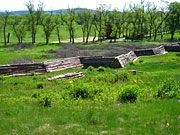Napoleon1er
2nd Lieutenant
- Joined
- Oct 11, 2010
- Messages
- 3,090
Mike I think yours is fabulous and probably more true to life given the time period. Even log homes built today aren't that perfect.
Can't agree more! Also, on a similar note, I have been doing a lot of experimenting with "logs" from my backyard. I might try using strait hollow reeds, and plug the ends with a drop of clay. They are VERY strait, easy to cut, very realistic, and probably very easy to notch. Also, I think that in the pictures, dowels were used, so I wouldn't beat yourself up because the straitest twig in your backyard is still not as strait as a factory turned dowel
Thanks,
Sandor




